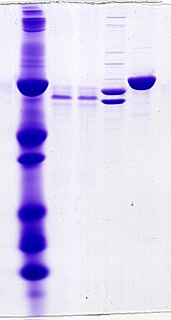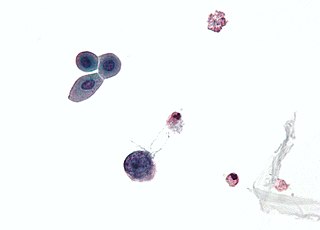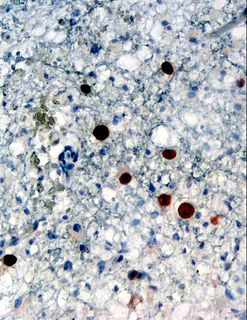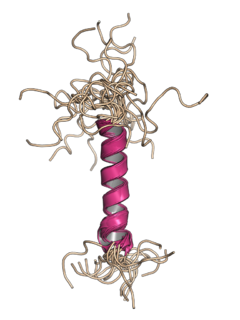Related Research Articles

Progressive multifocal leukoencephalopathy (PML) is a rare and often fatal viral disease characterized by progressive damage (-pathy) or inflammation of the white matter (leuko-) of the brain (-encephalo-) at multiple locations (multifocal). It is caused by the JC virus, which is normally present and kept under control by the immune system. The JC virus is harmless except in cases of weakened immune systems. In general, PML has a mortality rate of 30–50% in the first few months, and those who survive can be left with varying degrees of neurological disabilities.

Oligoclonal bands (OCBs) are bands of immunoglobulins that are seen when a patient's blood serum, or cerebrospinal fluid (CSF) is analyzed. They are used in the diagnosis of various neurological and blood diseases, especially in multiple sclerosis.

Polyomaviridae is a family of viruses whose natural hosts are primarily mammals and birds. As of 2020, there are six recognized genera and 117 species, five of which are unassigned to a genus. 14 species are known to infect humans, while others, such as Simian Virus 40, have been identified in humans to a lesser extent. Most of these viruses are very common and typically asymptomatic in most human populations studied. BK virus is associated with nephropathy in renal transplant and non-renal solid organ transplant patients, JC virus with progressive multifocal leukoencephalopathy, and Merkel cell virus with Merkel cell cancer.

Human polyomavirus 2, commonly referred to as the JC virus or John Cunningham virus, is a type of human polyomavirus. It was identified by electron microscopy in 1965 by ZuRhein and Chou, and by Silverman and Rubinstein, and later isolated in culture and named using the two initials of a patient, John Cunningham, with progressive multifocal leukoencephalopathy (PML). The virus causes PML and other diseases only in cases of immunodeficiency, as in AIDS or during treatment with immunosuppressive drugs.

Rituximab, sold under the brand name Rituxan, is a medication used to treat certain autoimmune diseases and types of cancer. It is used for non-Hodgkin lymphoma, chronic lymphocytic leukemia(in non-geriatric patients), rheumatoid arthritis, granulomatosis with polyangiitis, idiopathic thrombocytopenic purpura, pemphigus vulgaris, myasthenia gravis and Epstein–Barr virus-positive mucocutaneous ulcers. It is given by slow injection into a vein. Biosimilars of Rituxan include Blitzima, Riabni, Ritemvia, Rituenza, Rixathon, Ruxience, and Truxima.
This is a list of AIDS-related topics, many of which were originally taken from the public domain U.S. Department of Health Glossary of HIV/AIDS-Related Terms, 4th Edition.

Natalizumab, sold under the brand name Tysabri among others, is a medication used to treat multiple sclerosis and Crohn's disease. It is a humanized monoclonal antibody against the cell adhesion molecule α4-integrin. It is given by intravenous infusion every 28 days. The drug is believed to work by reducing the ability of inflammatory immune cells to attach to and pass through the cell layers lining the intestines and blood–brain barrier. Natalizumab has proven effective in treating the symptoms of both diseases, preventing relapse, vision loss, cognitive decline and significantly improving quality of life in people with multiple sclerosis, as well as increasing rates of remission and preventing relapse in multiple sclerosis.
In the United States, a boxed warning is a type of warning that appears on the package insert for certain prescription drugs, so called because the U.S. Food and Drug Administration specifies that it is formatted with a 'box' or border around the text. The FDA can require a pharmaceutical company to place a boxed warning on the labeling of a prescription drug, or in literature describing it. It is the strongest warning that the FDA requires, and signifies that medical studies indicate that the drug carries a significant risk of serious or even life-threatening adverse effects.
The genome and proteins of HIV have been the subject of extensive research since the discovery of the virus in 1983. "In the search for the causative agent, it was initially believed that the virus was a form of the Human T-cell leukemia virus (HTLV), which was known at the time to affect the human immune system and cause certain leukemias. However, researchers at the Pasteur Institute in Paris isolated a previously unknown and genetically distinct retrovirus in patients with AIDS which was later named HIV." Each virion comprises a viral envelope and associated matrix enclosing a capsid, which itself encloses two copies of the single-stranded RNA genome and several enzymes. The discovery of the virus itself occurred two years following the report of the first major cases of AIDS-associated illnesses.
A slow virus is a virus, or a viruslike agent, etiologically associated with a slow virus disease. A slow virus disease is a disease that, after an extended period of latency, follows a slow, progressive course spanning months to years, frequently involves the central nervous system, and in most cases progresses to death. Examples of slow virus diseases include HIV/AIDS, caused by the HIV virus, subacute sclerosing panencephalitis, the rare result of a measles virus infection, and Paget's disease of bone, which seems to be associated with paramyxoviruses, especially the measles virus and the human respiratory syncytial virus.
HIV-associated neurocognitive disorders (HAND) are neurological disorders associated with HIV infection and AIDS. It is a syndrome of progressive deterioration of memory, cognition, behavior, and motor function in HIV-infected individuals during the late stages of the disease, when immunodeficiency is severe. HAND may include neurological disorders of various severity. HIV-associated neurocognitive disorders are associated with a metabolic encephalopathy induced by HIV infection and fueled by immune activation of macrophages and microglia. These cells are actively infected with HIV and secrete neurotoxins of both host and viral origin. The essential features of HIV-associated dementia (HAD) are disabling cognitive impairment accompanied by motor dysfunction, speech problems and behavioral change. Cognitive impairment is characterised by mental slowness, trouble with memory and poor concentration. Motor symptoms include a loss of fine motor control leading to clumsiness, poor balance and tremors. Behavioral changes may include apathy, lethargy and diminished emotional responses and spontaneity. Histopathologically, it is identified by the infiltration of monocytes and macrophages into the central nervous system (CNS), gliosis, pallor of myelin sheaths, abnormalities of dendritic processes and neuronal loss.
Efalizumab is a formerly available medication designed to treat autoimmune diseases, originally marketed to treat psoriasis. As implied by the suffix -mab, it is a recombinant humanized monoclonal antibody administered once weekly by subcutaneous injection. Efalizumab binds to the CD11a subunit of lymphocyte function-associated antigen 1 and acts as an immunosuppressant by inhibiting lymphocyte activation and cell migration out of blood vessels into tissues. Efalizumab was associated with fatal brain infections and was withdrawn from the market in 2009.

Robert Charles Gallo is an American biomedical researcher. He is best known for his role in the discovery of the human immunodeficiency virus (HIV) as the infectious agent responsible for acquired immune deficiency syndrome (AIDS) and in the development of the HIV blood test, and he has been a major contributor to subsequent HIV research.
Neurovirology is an interdisciplinary field which represents a melding of clinical neuroscience, virology, immunology, and molecular biology. The main focus of the field is to study viruses capable of infecting the nervous system. In addition to this, the field studies the use of viruses to trace neuroanatomical pathways, for gene therapy, and to eliminate detrimental populations of neural cells.
Joseph R. Berger is an American internist and neurologist who is known for his research interests in progressive multifocal leukoencephalopathy (PML), the neurological complications of HIV/AIDS, multiple sclerosis, and other inflammatory disorders of the brain. Particularly, he contributed research on why PML occurs more frequently in AIDS than in other immunosuppressive conditions.

The stages of HIV infection are acute infection, latency and AIDS. Acute infection lasts for several weeks and may include symptoms such as fever, swollen lymph nodes, inflammation of the throat, rash, muscle pain, malaise, and mouth and esophageal sores. The latency stage involves few or no symptoms and can last anywhere from two weeks to twenty years or more, depending on the individual. AIDS, the final stage of HIV infection, is defined by low CD4+ T cell counts, various opportunistic infections, cancers and other conditions.
WU polyomavirus is a virus of the family Polyomaviridae. It was discovered in 2007 in samples of human respiratory secretions, originally from a child patient in Australia who presented with clinical signs of pneumonia and in whom other common respiratory viruses were not detected. Follow-up studies identified the presence of WU virus in respiratory secretion samples from patients in Australia and the United States, suggesting that, like other human polyomaviruses, WU virus is widely distributed.
KI polyomavirus is a virus of the family Polyomaviridae. It was discovered in 2007 in stored samples of human respiratory secretions collected by the Karolinska Institute, after which the virus is named.

Agnoprotein is a protein expressed by some members of the polyomavirus family from a gene called the agnogene. Polyomaviruses in which it occurs include two human polyomaviruses associated with disease, BK virus and JC virus, as well as the simian polyomavirus SV40.

Igor Koralnik is an American physician, neurologist and scientist. He is one of the first physicians to study the neurologic complications caused by the human immunodeficiency virus (HIV) and is a leading researcher in the investigation of the polyomavirus JC, which causes progressive multifocal leukoencephalopathy (PML), a disease of the central nervous system that occurs in immunosuppressed individuals.
References
- ↑ PubMed U.S. National Library of Medicine, National Institutes of Health PubMed search for "Major EO" as conducted on February 2, 2010.
- 1 2 3 4 5 Laboratory homepage Laboratory of Molecular Medicine and Neuroscience - Division of Intramural Research. Eugene O. Major, Ph.D., Senior Investigator.
- ↑ Molinaro, G. A.; Major, E. O.; Bernhardt, G.; Dray, S.; Di Mayorca, G. (1977). "Similar cell surface antigens on hamster cells transformed by different papovaviruses". Journal of Immunology. 118 (6): 2295–2298. PMID 68085.
- ↑ Wright, P. J.; Bernhardt, G.; Major, E. O.; Di Mayorca, G. (1976). "Comparison of the serology, transforming ability, and polypeptide composition of human papovaviruses isolated from urine". Journal of Virology. 17 (3): 762–775. doi:10.1128/JVI.17.3.762-775.1976. PMC 515475 . PMID 56460.
- ↑ Major, E. O.; Di Mayorca, G. (1973). "Malignant Transformation of BHK21 Clone 13 Cells by BK Virus—A Human Papovavirus". Proceedings of the National Academy of Sciences of the United States of America. 70 (11): 3210–3212. Bibcode:1973PNAS...70.3210M. doi: 10.1073/pnas.70.11.3210 . PMC 427202 . PMID 4361683.
- ↑ Olive, DM; Lampert, M; Major, EO (1980). "Comparison of wild-type BK virus DNA and BK virion DNA rescued from virus-transformed BHK cells". Virology. 103 (1): 1–10. doi:10.1016/0042-6822(80)90121-X. PMID 6245520.
- ↑ Bourne, KA; Major, EO; Khoobyarian, N (1978). "A variant of adenovirus 12 producing cytoplasmic accumulation of capsid proteins". The Journal of General Virology. 40 (3): 685–9. doi: 10.1099/0022-1317-40-3-685 . PMID 690616.
- ↑ Major, E. O. (1983). "JC virus T protein expression in owl monkey tumor cell lines". Progress in Clinical and Biological Research. 105: 289–298. PMID 6304765.
- ↑ Major, E. O.; Matsumura, P. (1984). "Human embryonic kidney cells: stable transformation with an origin-defective simian virus 40 DNA and use as hosts for human papovavirus replication". Molecular and Cellular Biology. 4 (2): 379–382. doi:10.1128/mcb.4.2.379. PMC 368707 . PMID 6321962.
- ↑ Berger, J.; Tornatore, C.; Major, E.; Bruce, J.; Shapshak, P.; Yoshioka, M.; Houff, S.; Sheremata, W.; Horton, G.; Landy, H. (1992). "Relapsing and remitting human immunodeficiency virus-associated leukoencephalomyelopathy". Annals of Neurology. 31 (1): 34–38. doi:10.1002/ana.410310107. PMID 1311910. S2CID 44437188.
- ↑ D'Costa, J.; Harvey-White, J.; Qasba, P.; Limaye, A.; Kaneski, C.; Davis-Warren, A.; Brady, R.; Bankiewicz, K.; Major, E.; Arya, S. K. (2003). "HIV-2 derived lentiviral vectors: gene transfer in Parkinson's and Fabry disease models in vitro". Journal of Medical Virology. 71 (2): 173–182. doi:10.1002/jmv.10467. PMID 12938190. S2CID 31437426.
- ↑ Donati, D.; Martinelli, E.; Cassiani-Ingoni, R.; Ahlqvist, J.; Hou, J.; Major, E.; Jacobson, S. (2005). "Variant-specific tropism of human herpesvirus 6 in human astrocytes". Journal of Virology. 79 (15): 9439–9448. doi:10.1128/JVI.79.15.9439-9448.2005. PMC 1181567 . PMID 16014907.
- ↑ Grigolo, B.; Roseti, L.; Neri, S.; Gobbi, P.; Jensen, P.; Major, E. O.; Facchini, A. (2002). "Human articular chondrocytes immortalized by HPV-16 E6 and E7 genes: Maintenance of differentiated phenotype under defined culture conditions". Osteoarthritis and Cartilage. 10 (11): 879–889. doi: 10.1053/joca.2002.0836 . PMID 12435333.
- ↑ Biogen, Elan, Roche In Brain Infection Consortium Wall Street Journal, Thomas Gryta, November 11, 2009.
- ↑ Biogen’s Tysabri for MS Also Lowers Defense Against Brain Virus Bloomberg, Elizabeth Lopatto, September 9, 2009.
- ↑ Anti-Inflammatory Drug's Potentially Deadly Side Effect Found To Be Rare Science Daily, March 3, 2006.
- ↑ Evaluation of Patients Treated With Natalizumab (Tysabri) Finds No New Cases of Progressive Multifocal Leukoencephalopathy Doctor's Guide News, March 3, 2006.
- ↑ Tysabri retards progression of multiple sclerosis: trials Earth Times, March 2, 2006.
- ↑ "NIH Study Finds No New Cases of PML in Tysabri Patients," Drug Industry Daily (Dow Jones), March 3, 2006.
- ↑ Tysabri(R) Two-Year Phase III Multiple Sclerosis Clinical Trial Results And Safety Evaluation Published In NEJM Medical News Today, March 6, 2006.
- ↑ Analysis: Tysabri review finds no more PML cases UPI Health Business, Steve Mitchell, March 1, 2006.
- ↑ Ask the Experts: Differential Diagnosis of White-Matter Brain Disease Medscape, David M. Simpson, MD, September 25, 2001.